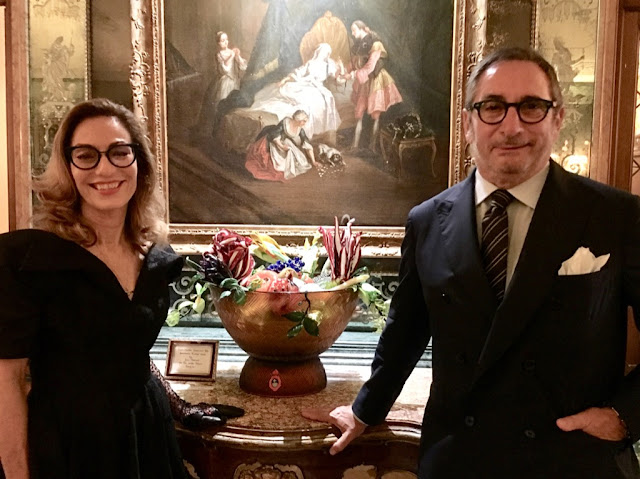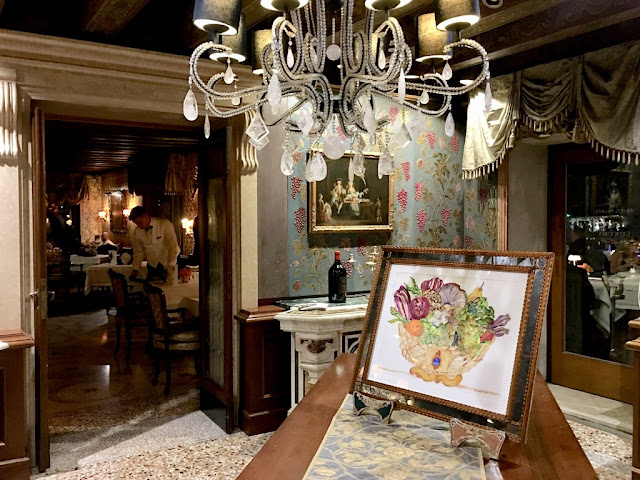The Venice Glass Week
9-16 September 2018
In
it’s second year The Venice Glass Week is an international festival dedicated to the art of glass, with a particular focus on that of Murano. The festival involves many of
the major institutions in Venice, Murano
and Mestre, with the aim of revitalizing and sustaining one of the city’s most important artistic and creative
activities.
Above.
Centrotavola Veneziano – Judi Harvest for The Gritti Palace.
Judi Harvest - Centrotavola
Veneziano
The Gritti Palace Venice
Centrotavola Veneziano is a completely handmade Murano glass sculpture celebrating the
fruits, vegetables and flowers indigenous to the Venetian Lagoon and the Veneto,
conceived and executed by artist Judi
Harvest. With a long history of creating works in Murano glass and
exhibitions in Venice and around the
world, Judi is very proud to work with The
Gritti Palace, A Luxury Collection
Hotel on this new creation which will be permanently displayed in The Gritti Epicurean School. This sculpture was inspired by the Honey Garden in Murano on Sacca Serenella that she planted in 2013 for the factory where she has
worked for the past 30 years and the 8 healthy Honeybee colonies she installed
and cares for at the factory. With the help of the Honeybees, she has bottled the first Murano Honey, which was served at the event.
Judi Harvest and Paolo Lorenzoni
“In the 19th century, elaborate,
festive centerpieces were seen by the aristocracy as a celebration of beauty
and wealth. Embodying this sense of
allure, Harvest’s Centrotavola Veneziano for The Gritti Palace is a masterful
homage to the history of Murano glass and the ancient form’s namesake island.”
Barbara Rose
Judi Harvest
- Centrotavola Veneziano - 2018
Watercolor on
paper with frame
The Party
Watercolors of vegetables from the Venetian Lagoon hang on the walls of The
Gritti Epicurean School
where the party was held.
Giorgio Giuman
Judi Harvest – Pomegranate – 2018
Harvest - Murano Honey
The Party
Alessandra Morgagni, Carla Plessi and Barbara
Rose
Giorgio Vigna - Acque
Palazzo Fortuny
The
installation Acque, exhibited on the
piano nobile of Palazzo Fortuny, was
created by Giorgio Vigna from works
produced between 2013 and 2015. Acque is part of a research project with which
the artist explores the possibilities of glass in relation between fire and
water. With this work he transforms simple copper containers into signs with a
mystical value. The first works in this research were exhibited at Palazzo
Fortuny in 2010 on the occasion of his solo exhibition.
Giorgio Vigna
Giorgio
Vigna - Acque
Ronan and Erwan Bouroullec – Alcova
Giorgio Mastinu Fine Art Gallery
“The Alcova collection is a series
of coloured cast glass geometrical shapes that are organically composed. We
approached this project in a brutal and primary way, working with the thickness
of the material and letting the process guide us, seeking to preserve all the
magic of the ballet of molten glass manipulated by master glassmakers.”
Ronan and Erwan Bouroullec
Ronan Bouroullec – Some
Drawings
Smiljan Radic - sculpture - Ronan Bouroullec - drawing collage
Enzo Mari - Zigurrat
Ronan Bouroullec – Some
Drawings
Giorgio Mastinu Fine Art Gallery
The Giorgio Mastinu Fine Art Gallery, during
The Venice Glass Week, also displayed
Some Drawings by Ronan Bouroullec.
Giorgio Mastinu
Gaby Wagner – Glass Installation
Palwer Gallery
The Palwer
Gallery presented designer and photographer Gaby Wagner’s Glass
Installation. Gaby Wagner entered
the glass world in 2000 after a collaboration with Laura de Santillana. Fascinated by glass as a material, she immediately
understood its potential and realized some objects with master glass blower Aureliano Toso on Murano. Her glass
stones are round and flat shapes, as if they were worn from water and are
enlivened by the use of gold leaf. She looks
at the ancient as an inexhaustible source of inspiration.
Gaby Wagner
Gaby Wagner – Glass Installation
Gold Flame - Green
Alessandro Palwer
Gaby Wagner - Glass
Installation
Alice Diaz de Santillana – Think Ephemeral
Chiarastella Cattana
Experiments in glass, archetypes and
prototypes, small fragile spaces of shelter; seed and shells; Alice Diaz de Santillana’s
glass allows us to discreetly enter her practice. These new glass objects are among her first
experiments connecting and explaining many stories.
“Think Ephemeral
represents the fusion of my creative and technical experience in the world of
Haute Couture and the influence of my family’s long term involvement with the
artistic tradition of Murano glass—my great-grandfather was Paolo Venini. These
two artistic ingredients have been the primary influences on the progression of
my own aesthetic trajectory. I conceived this project to create a dialog
between the disparate worlds of fashion and glass. Designed as a limited series
of “Portable Art” that combines traditional Muranese glassblowing techniques
with textiles and metals, the pieces also incorporate art with practical
applications. They may vary in usage and can be carried to any occasion as a
clutch, used as a jewelry box or simply as a cherished decoration, always with
the purpose of adding a refined and unique atmosphere.”
Alice Diaz de Santillana
Alice Diaz de Santillana – Think Ephemeral
Chiarastella Cattana
Chiarastella Cattana
Marta Sforni – Light Touch
Hugues Le Gallais – Ca
del Duca
Galleria Riccardo Crespi
The works of Marta Sforni are intrinsically linked to the city of Venice, which the artist defines as her
“muse”. In fact, it is in the Venetian scenario that all the key concepts of her painting unfold:
transparency and light, fragility and beauty, memory and identity, decoration
and voluptuousness, enigma and symbol, escape and emptiness.
Marta Sforni - Hungry Ghost
oil on Linen
In the works on display, starting
from a careful analysis of styles and values of an era dear to the artist, back
at the time of her architectural studies in Venice, the eighteenth century,
Marta Sforni unceasingly explores all forms and variations of glass as a universal
symbol, through painting.
“Candelabra and mirror constitute
the focus of Forni’s painting as her physical subject, but these object simultaneously
serve as vehicles – as a material-ephemeral pretext to not only illuminate but
also expose indescribable vitality. The
objects themselves simply offer an occasion to confront the basic requirements
of painting anew in every picture – a vivid balancing act of light and shadows,
of forms and formlessness, of appearance and disappearance, a balancing act which
obeys the autonomous limitations of force and dimension, and which goes beyond
actual reality.”
Thomas Groetz
Marta Sforni – Largo
oil on linen
Riccardo Crespi
Cristiano Bianchin – Figures
Gallerie dell’ Accademia
On the occasion of The Venice Glass Week 2018, the Gallerie dell’Accademia, in
collaboration with Caterina Tognon Vetro
Contemporaneo, presented a selection of glass sculptures by Cristiano Bianchin (Venice, 1963). For the second time, the
Gallerie dell’Accademia take part in the international kermesse dedicated
to glass, exposing an artist who, since 1992, has almost exclusively worked on
the creation of art in this material and has worked with great continuity and
dedication in the furnaces of Murano:
the Anfora furnace, led by Renzo Ferro with the master glassworker Andrea Zilio and master cold worker Giacomo Barbini, have become his artistic residence.
Cristiano Bianchin –
Raccoglitore di Pensieri – Urna – 2001
Cristiano Bianchin and Caterina Tognon
Cristiano Bianchin – Figures
In the apse of the former gothic church of Santa Maria della Carita, one of the
most magical and evocative places of the museum, are presented six sculptures
from Cristiano Bianchin’s series Crisalidi. The sinuous and elegant anthropomorphic glass works
bring to mind figures of saints that emerge from the wood panels painted almost
six hundred years ago in Jacopo Bellini’s
atelier, very likely in collaboration with his sons Giovanni and Gentile. The Crisalidi series, produced in Murano in the early 2000s, are intended
by Bianchin as contemporary idols that recall the typical hieratic shapes of
ancient statuary. For the artist, black opaque glass, which is rarely used in
glass art, symbolizes purity, order and sensuality.
Cristiano Bianchin – Riposapesi – 2001-2004
Cristiano Bianchin responds to the
whiteness of Antonio Canova’s plaster
casts, which populate the Palladian
hall, with the vibrancy of Murano
glass colors. As early as 1995 the Venetian
artist had created a connection with the great master of Neoclassicism in the Gipsoteca of Possagno: today, more than twenty years
later, Bianchin reflects once again on the relation between his artwork and
Canova’s plaster casts.
Galleria Alessandro Zoppi – Parecio
Curator - Umberto Branchini
Parecio, table settings, is the title of Galleria Alessandro Zoppi's proposition for the 2018 edition of The
Venice Glass Week. An art merchant and Venetian glass expert, Alessandro Zoppi opened his first
gallery in Calle Larga XXII Marzo in
1992, where he dealt in 18th century
glassware - chalices, vases, mirrors and chandeliers - the most influential
names in modern Venetian glass, such as Alfredo
Barbini, Vittorio Zecchin, Tomaso Buzzi, Dino Martens, Napoleone Martinuzzi,
Archimede Seguso, Carlo Scarpa. As of last December the gallery has moved
to Campo S. Maurizio, in a larger
space better suited to host small themed exhibitions.
Alessandro Zoppi
Galleria Alessandro Zoppi – Parecio
Parecio offers a full
panorama of Venetian glass
tableware. Plates, carafes, goblets, ampoules, cake-stands and more are
arranged to create a historic banquet of sorts: commencing in the 18th century,
weaving its way through the rare examples of the 1800s and the masters of the
20th century, culminating in an object specially designed by interior
designer Umberto Branchini for The Venice Glass Week. The exhibition
thus presents itself as a journey into the creativity and ingenuity of Muranese glass production, highlighting
the evolution of taste for the dining table's visual elements over a period of
more than 300 years.
Galleria Alessandro Zoppi – Parecio
Pin It



































